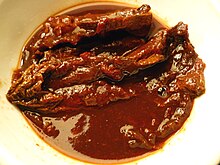Cookbook:Chipotle Pepper
| Chipotle Pepper | |
|---|---|
 | |
| Category | Herbs and spices |
Cookbook | Recipes | Ingredients
The chipotle pepper is a smoked and dried ripe jalapeño pepper.[1][2][3] It can come in different forms for use in cooking.
Characteristics[edit | edit source]

All chipotles are wrinkled and have a smoky, medium spicy flavor with a hint of fruity sweetness.[2][4] Two primary varieties of chipotle exist: morita and meco.[1] Moritas are dark red with a pliable texture similar to that of a raisin.[2][3] They are not smoked as long, which gives them a milder flavor.[3] On the other hand, mecos are smoked for much longer, which turns them brown and gives them an intensity of flavor.[2][3]

Once dried, chipotles may be processed in a few ways. They can be sold whole or ground to flakes or powder.[1] They may also be be stewed in adobo sauce—a blend of tomato, vinegar, and spices—and canned to make a versatile condiment.[3][5][6] When rehydrated, they can be blended to make a chipotle purée.
Selection and storage[edit | edit source]
As a dried food, chipotles keep well at room temperature when kept away from light, heat, air, and moisture.[2] Under ideal conditions, they can last for a couple years.[2] Canned chiles in adobo can last for days to weeks in the fridge after opening.[5]
Preparation[edit | edit source]
Before using chipotles, remove the stems, and discard the seeds if desired to reduce the bitterness of the chile.[2][3] If you want to add additional char and flavor, you can dry toast them in a skillet before proceeding.[3] From here, you can grind or rehydrate them.[2] To rehydrate, cut a little slit in the sides and soak in hot water—or another liquid—for several minutes.[2][7]
Use[edit | edit source]
Chipotles are commonly used in Mexican cuisine, as well as Tex-Mex and United States cuisines.[3] The ground powder makes a good component of a meat rub.[1] Chipotles in adobo are excellent as part of condiments and marinades, where the adobo adds a tang and the chile adds spice and smoke.[3][5]
Recipes[edit | edit source]
References[edit | edit source]
- ↑ a b c d "Spice Hunting: Chipotle".
- ↑ a b c d e f g h i "What is a Chipotle Chile - Spices Inc". spicesinc.com. Retrieved 2024-05-05.
- ↑ a b c d e f g h i "A Complete Guide Chipotle Chiles (Meco & Morita)". diversivore. Retrieved 2024-05-05.
- ↑ Farrimond, Dr Stuart (2018-11-06). The Science of Spice: Understand Flavor Connections and Revolutionize Your Cooking. National Geographic Books. ISBN 978-1-4654-7557-2.
- ↑ a b c "Everything You Can Do With a Can of Chipotles in Adobo". Serious Eats. Retrieved 2024-05-05.
- ↑ Labensky, Sarah R.; Hause, Alan M.; Martel, Priscilla (2018-01-18). On Cooking: A Textbook of Culinary Fundamentals. Pearson. ISBN 978-0-13-444190-0.
- ↑ Kipfer, Barbara Ann (2012-04-11). The Culinarian: A Kitchen Desk Reference. Houghton Mifflin Harcourt. ISBN 978-0-544-18603-3.